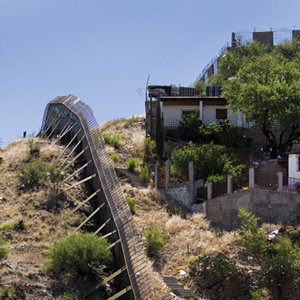Political attention targeting the U.S.-Mexico border region has prompted Gray Line of Tucson to come up with a new tour concept that drops passengers off at the border for a firsthand look at what is going on along the hotly-disputed line of demarcation. The company suggests that people should not let politicians and news broadcasters be their only source of information.
Gray Line Tours took a group of 12 on its inaugural run of Border Crisis: Fact and Fiction Tour in late May, covering a variety of sites along the border on, what Gray Line Tours calls, a personal fact-finding mission.
With the support of Humane Borders and the Santa Cruz Community Foundation, Gray Line will conduct two all-day apolitical tours a month throughout the summer at a cost of $89 per adult, lunch included. Bob Feinman, a volunteer for non-profits Humane Borders and the Santa Cruz Community Foundation, serves as the tour guide. While Feinman has worked with Gray Line for years on various tours, he says the new Border Crisis tour is very different.
“The people at Gray Line and I had the idea for the tour about nine months ago,” says Feinman. “We spent probably seven to eight months kicking this concept around before we were actually able to get it going. The easy part was coming up with the idea. The tough part was getting everyone we needed in Santa Cruz County to implement it. Part of what we needed was some information only the federal government could provide, as well as its participation.”
Feinman says they wanted access to information in order to give people a real feel for what goes on along the Arizona-Mexico border.
“How many people cross the border and what percentage are good guys and bad guys,” he says. “We saw these as questions that would be of interest to our tour passengers. Any time anyone has to deal with the federal government, they face bureaucracies and budget cuts. We had a lot of road blocks, and that’s why it took so long to get off the ground.”
On down to Nogales
The tour begins in Tucson, with two stops along the 60-mile route south to Nogales, Arizona and the border. The first stop is at a water tank in Arivaca, placed there by Humane Borders for use by stranded people, whether they are undocumented aliens or hikers lost in the desert and needing a drink. For some, the water tanks can be the difference between life and death.
Feinman is quick to point out that Humane Borders has no political agenda and that the water tanks are on land where the landowners have given their permission.
In Nogales, passengers disembark at the town’s fruit and produce market for a boxed lunch and to hear speakers discussing border issues. From there, passengers tour the border wall on foot and experience the Mariposa and DeConcini Point of Entry facility. On the return trip to Tucson, passengers get to interact and talk with border officials and ranchers about life in the area.
Feinman says the majority of news coverage is disseminated by reporters and people who do not work or live in the area.
“We’re hoping these tours give people the opportunity to make up their own mind about what goes on along the border,” he says. “Every politician is talking about the border. Our mission is to let the border make a statement for itself. The mission is not to turn passengers into a liberal or a conservative.”
Feinman says he hopes the tour grows into more than just a bimonthly event.
“I’d like to go beyond the current tour,” he says. “We like to start designing a tour that would actually take people across the border on foot into Nogales, Sonora, Mexico.”


